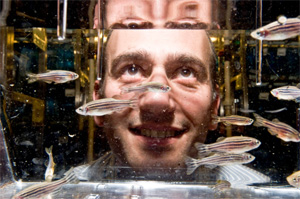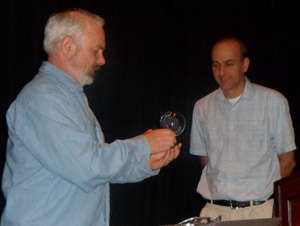BioEYES Awarded Viktor Hamburger Outstanding Educator Prize
By Marsha E. Lucas
The Society for
Developmental Biology awarded the 2012
Viktor
Hamburger Outstanding Educator Prize to
BioEYES and
its co-directors
Steven Farber of the Carnegie
Institution for Science and
Jamie Shuda of the
University of Pennsylvania. BioEYES is a K-12
science education program that brings live zebrafish
into the classroom to teach basic biology, including
development, genetics, and ecology. The week-long
program has students identify male and female fish,
set up crosses, collect embryos, make scientific
observations and test hypotheses.
|
 |
|
Steven Farber (Image courtesy of NY
Times) |
Farber, a
developmental biologist, and Shuda, a former 3rd
grade teacher, formed BioEYES in 2002. It was a
natural outgrowth of the lab tours Farber began
giving in 2001 as an assistant professor at Thomas
Jefferson University during their campus-wide “Take
Your Child to Work Day.” The children were able to
observe adult zebrafish, as well as developing
embryos and larvae under the microscope. They
overwhelmingly reported back that seeing the fish
was the best part of their day. After countless lab
tours and slightly annoyed lab personnel, Farber
asked the Dean if they could get money to hire a
full-time person to do outreach. Shuda came on board
soon after.
The partnership of a
scientist and an educator made BioEYES a success.
Shuda was able to take Farber’s many great ideas,
and then hone in on those that were actually doable
for a classroom of 30 students. She studied the
educational standards for different age groups and
designed the BioEYES program around them. In an
interview prior to the SDB meeting she said her
focus was “how can we take something that’s already
suppose to be taught, but do it in a way that’s very
student centered, that actually gets them to explore
science, and allows the teachers to actually have
fun teaching these concepts.” The program gets
students to think like a scientist while at the same
time reinforces basic reading, writing, and math
skills.
|
 |
|
Jamie Shuda with two BioEYES students.
(Image courtesy of University of
Pennsylvania) |
“We teach in some of
the most elite private schools in Philadelphia and
some of the poorest neighborhoods in West
Philadelphia and everybody gets a learning
experience that they carry with them,” Shuda said.
“I think that that’s what teachers appreciate ...
that you don’t have to read on grade level to do
BioEYES. English doesn’t have to be your first
language.” BioEYES is for everyone.
In fact, student
assessments across age groups show the students do
learn the concepts put forth in their BioEYES
modules. The pie graph below, for example, shows results
of an advanced assessment question geared
toward high school students. After a week of
BioEYES, more students
know what a stem cell is.
|
 |
|
2010-2011
BioEYES Advanced Level Assessment
Question Results for Baltimore.
(Image courtesy of BioEYES) |
Both Farber and
Shuda expressed their appreciation for BioEYES being
recognized by the developmental biology community.
“I feel just ecstatic about,” Farber said. “I always
tell people I didn’t wake up one day and think that
BioEYES in all of its forms and success was the
plan. I was just starting kind of small and I think
once Jamie got involved and really took off with the
idea, it just took on a life of its on. So, it’s
gratifying ... and I think the SDB as a partner has
really helped us at critical times in keeping it
going and supporting its growth.”
“For me as an
educator, I think it's fantastic that there’s a
science society ... that is so interested and
passionate about education,” Shuda said.
More than 50,000
students have participated in BioEYES in
Philadelphia, PA; Baltimore, MD; South Bend, IN; and
Melbourne, Australia. According to Shuda, there is
currently a waitlist in most of these cities of
teachers who want to do BioEYES. Shuda said, their
priority going forward is “growing the program to
meet the demand.”
This of course
requires adequate funding. Farber and Shuda are
always writing grants. “We are constantly
strategizing and we have panic moments,” Farber
said. BioEYES is funded by many local foundations
who want to support science education. They also get
funding from faculty who want to add an outreach
component and enhance the “broader impacts” of their
grants from the National Science Foundation or the
National Institutes of Health. BioEYES is written
into their grant proposals and when those grants get
funded, BioEYES gets money to continue their
programs. In addition, the grant recipients and
their lab members can take part in an already
existing program.
In order to meet its
growing demands the program also seeks to develop
more master teachers. These are teachers who have
had BioEYES in their classrooms for at least two
years, have attended the teacher training sessions,
and are comfortable with the material. “We call on
them to come back and train new teachers and help us
recruit new teachers,” Shuda said. “When they sign
up for their BioEYES week, we actually just give
them all the equipment and supplies, and they
conduct the experiment with their students on their
own.”
These master
teachers often report back on changes they have made
or activities they created that they think could
benefit all of BioEYES. “That has helped us expand
... and grow in a way we hadn’t anticipated,” Shuda
said.
|
 |
|
Scott Gilbert presents Farber with the
Hamburger Prize at the 71st SDB Annual
Meeting in Montreal, Canada. Shuda
was unable to attend and received her
award following the meeting. |
Farber actually
expected teachers to pick it up faster. “I thought
it would be easy and that every teacher would become
a master teacher because I guess I didn’t really
understand the literacy levels or the variation in
science literacy among teachers,” he said.
This is why Shuda
and Farber are looking to expand the teacher
professional development aspect of BioEYES. “When
you really change substantively a teacher, you
change all the kids that teacher’s going to teach
[throughout] their career,” Farber said.
They also want to
affect pre-service teachers—those in the process of
getting their degrees. “How do we change their
experience as they’re learning about education in
science when they actually can afford the time to
spend in labs?” Shuda said. “If we take it seriously
and actually integrate it into their academic
experience, then we’re preparing them I think even
more.”
To help facilitate
this, BioEYES is working on a partnership with the
Johns Hopkins School of Education, where Farber and
Shuda have both been given secondary appointments.
The School of Education has “acknowledged the impact
of our program and [sees] it as a model for
replication, and that will bring our voice to the
table so we can talk about what we think the future
of both professional development and pre-service
should be for teachers,” Shuda said.
The program has come
a long way since its early days. Shuda said, “I’m
just extremely grateful that a society, the Society
for Developmental Biology, has acknowledged our
program and has supported us from the ground up. ...
Being able to say that SDB has been the support for
us as we’ve grown has just been a really great
experience for Steve and I.”
|